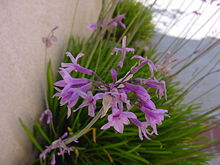bio.wikisort.org - Plant
Tulbaghia (wild garlic[2] or society garlic) is a genus of monocotyledonous herbaceous perennial bulbs native to Africa,[1] belonging to the amaryllis family. It is one of only two known genera in the society garlic tribe within the onion subfamily.[3] The genus was named for Ryk Tulbagh (1699–1771), one time governor of The Cape of Good Hope.[4]
| Society garlic | |
|---|---|
 | |
| Tulbaghia violacea | |
| Scientific classification | |
| Kingdom: | Plantae |
| Clade: | Tracheophytes |
| Clade: | Angiosperms |
| Clade: | Monocots |
| Order: | Asparagales |
| Family: | Amaryllidaceae |
| Subfamily: | Allioideae |
| Tribe: | Tulbaghieae |
| Genus: | Tulbaghia L. 1771, conserved name not Heister 1755 |
| Synonyms[1] | |
|
Omentaria Salisb. | |

Most species are native to the Eastern Cape Province of South Africa. As is common to many members of the Allioideae, when their leaves are bruised they produce a distinct garlic smell, hence its common name. The flowers are borne in an umbel. Each flower has six narrow tepals. A characteristic of the genus is that there is a "corona" – a raised crown-like structure – at the centre of the flower. This may be small and scale-like or may be larger, somewhat like the trumpet of a small narcissus.[5]
- Tulbaghia acutiloba Harv. – Botswana, Lesotho, Eswatini, South Africa
- Tulbaghia aequinoctialis Welw. ex Baker – Angola
- Tulbaghia alliacea L.f., syn. Tulbaghia affinis – Botswana, Zimbabwe, Zambia, South Africa
- Tulbaghia calcarea Engl. & Krause – Namibia
- Tulbaghia cameronii Baker – Cameroon, Zaire, Tanzania, Malawi, Mozambique, Zambia, Zimbabwe, Namibia
- Tulbaghia capensis L. – Cape Province
- Tulbaghia cernua Fisch. – Botswana, Lesotho, South Africa
- Tulbaghia coddii Vosa & R.B.Burb. – Mpumalanga
- Tulbaghia cominsii Vosa – Cape Province
- Tulbaghia dregeana Kunth – Cape Province
- Tulbaghia friesii Suess. – Nyanga Mountains of Mozambique + Zimbabwe
- Tulbaghia galpinii Schltr. – Cape Province
- Tulbaghia leucantha Baker – Botswana, Lesotho, Eswatini, South Africa, Zambia, Zimbabwe, Namibia
- Tulbaghia ludwigiana Harv. – Eswatini, South Africa
- Tulbaghia luebbertiana Engl. & Krause – Namibia
- Tulbaghia macrocarpa Vosa – Zimbabwe
- Tulbaghia montana Vosa – Cape Province
- Tulbaghia natalensis Baker – Cape Province, KwaZulu-Natal
- Tulbaghia nutans Vosa – Mpumalanga
- Tulbaghia pretoriensis Vosa & Condy – Gauteng
- Tulbaghia rhodesica R.E.Fr. – Tanzania, Zambia
- Tulbaghia simmleri Beauverd – Northern Province
- Tulbaghia tenuior K.Krause & Dinter – Cape Province, Namibia
- Tulbaghia transvaalensis Vosa – Limpopo, KwaZulu-Natal
- Tulbaghia verdoornia Vosa & R.B.Burb. – Cape Province
- Tulbaghia violacea Harv. – Society garlic[7] – Cape Province, KwaZulu-Natal; naturalized in Tanzania + Mexico
- formerly included[1]
A few names have been coined using the name Tulbaghia, but applied to species now considered better suited to the genus Agapanthus.
- Tulbaghia africana – Agapanthus africanus
- Tulbaghia heisteri – Agapanthus africanus
- Tulbaghia minor – Agapanthus africanus
- Tulbaghia praecox – Agapanthus praecox
References
- World Checklist of Selected Plant Families, The Board of Trustees of the Royal Botanic Gardens, Kew, retrieved 2011-11-13, search for "Tulbaghia"
- USDA, NRCS (n.d.). "Tulbaghia". The PLANTS Database (plants.usda.gov). Greensboro, North Carolina: National Plant Data Team. Retrieved 12 December 2015.
- Stevens, P.F., Angiosperm Phylogeny Website: Asparagales: Allioideae
- Gledhill, D. (1994), The Names of Plants, Cambridge, UK: Cambridge University Press, ISBN 978-0-521-36675-5, p. 189
- Armitage, James (August 2007), "Time for Tulbaghia", The Garden, 136 (8): 524–527
- South African National Biodiversity Institute, Red List of South African Plants, search for Tulbaghia
- Tulbaghia violacea on Floridata
На других языках
- [en] Tulbaghia
[es] Tulbaghia
Tulbhagia es un género de plantas herbáceas, perennes y bulbosas con aproximadamente 30 especies originarias de África, perteneciente a la familia Amaryllidaceae.[1][ru] Тульбагия
Тульбагия (лат. Tulbaghia) — род многолетних травянистых растений подсемейства Луковые (Allioideae) семейства Амариллисовые (Amaryllidaceae), единственный представитель трибы Tulbaghieae.Другой контент может иметь иную лицензию. Перед использованием материалов сайта WikiSort.org внимательно изучите правила лицензирования конкретных элементов наполнения сайта.
WikiSort.org - проект по пересортировке и дополнению контента Википедии